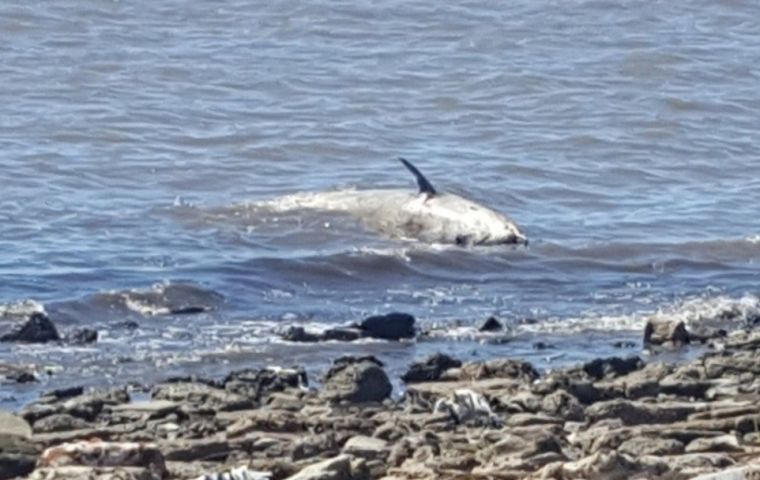MercoPress. South Atlantic News Agency
Dead whale found north of Buenos Aires City
 Although unusual, it was not the first time a dead whale turned up dead in Vicente López
Although unusual, it was not the first time a dead whale turned up dead in Vicente López A dead whale was found a few meters from the shore in Vicente López, on the northern outskirts of the Autonomous City of Buenos Aires, Argentina. A fisherman spotted the animal, believed to be a young calf, near kilometer 18 of the coastal channel in La Lucila and reported it to the Coast Guard (PNA), which, together with Civil Defense and local Police, established a security perimeter around it. The whale had its fins facing upward.
The fisherman who made the discovery mentioned seeing the whale near San Isidro a week prior, noting its unusual presence alone. “A week ago, we saw it several times, alone, near San Isidro, when we went fishing there. It seemed strange to me. And today, when we arrived, it was here. So we called 106,” the fisherman who contacted emergency services to report the discovery told A24. “I arrived around 6 a.m. and it was already there,” he revealed, adding, “Unfortunately, it came here to die.”
In 2016, a dead beaked whale was found in Vicente López. Historical records also show a blue whale washed ashore in Olivos in 1936. More recently, in Castelli, a district without sea access, a 12-meter humpback whale was stranded in a canal for over two weeks almost a year ago, likely having lost its way while seeking food.
According to Juan Pablo Loureiro, a veterinarian at Mundo Marino Park and Foundation, the whale is a young rorqual, a type of baleen whale that migrates along the coast. While it is uncommon for these animals to be found so close to shore, it is possible the whale died at sea and was carried to the coast by the tide.
Several factors could contribute to such strandings and deaths. Whales can suffer from natural or infectious diseases like brucellosis, tuberculosis, or nocardia (a bacterium causing pneumonia). Additionally, ingesting toxic algae from blooms, often related to “red tide” and climate change, can poison these animals, while fishing nets, ropes, or other marine debris can cause internal injuries, the expert explained.
“When an animal of this type strands, it attracts the attention of everyone, of any neighbor, of anyone who sees it, because it is characterized by its large size. From what we can see in the images that were released, the type of whale would be within the rorqual family,” Loureiro told Clarín.
“From what we can see, we can say that it is a young animal. And it is important to know that all these species of rorqual whales on our coasts are whales that migrate along the coast. This is fundamental. These are animals that are currently migrating, and unfortunately, in this case, an animal that appeared on the coast has died,” he added.




Top Comments
Disclaimer & comment rulesCommenting for this story is now closed.
If you have a Facebook account, become a fan and comment on our Facebook Page!